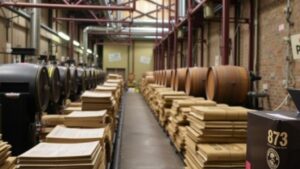Exploring Historical Farmstead Blueprints for Hidden Agricultural Tools
Exploring Historical Farmstead Blueprints for Hidden Agricultural Tools
The study of historical farmstead blueprints reveals a wealth of information not only about architectural styles but also about the agricultural tools used in the past. These blueprints often include detailed depictions of outbuildings, barn layouts, and tool storage, which provide insights into the agricultural practices of their time. This article delves into the significance of these blueprints and highlights specific examples where such documents yield critical information on agricultural tools, their usage, and the evolution of farming methodologies.
Historical Context of Farmsteads
Farmsteads have evolved significantly from the colonial period in America to the present day. Early American farmsteads, which can be traced back to the 1600s, often reflected the agricultural needs and technologies of their era. For example, the 19th-century family farms in the Midwest showcased a variety of outbuildings that were tailored for specific agricultural functions, embodying a practical response to location and farming styles.
Types of Agricultural Tools Reflected in Blueprints
Blueprints of historical farmsteads often provide valuable insights into the agricultural tools and machinery used at the time. The physical layout of barns and outbuildings typically illustrates where specific tools would have been stored or utilized. Some common tools identified through historical blueprints include:
- Hand Tools: Items such as hoes, rakes, and shovels were often depicted in storage areas and were essential for daily agricultural tasks.
- Animal-Powered Tools: Many blueprints indicate spaces for machinery like plows and harrows which were typically pulled by horses or oxen.
- Storage Equipment: Sheds designed for horse-drawn equipment were common, illustrating the importance of maintaining mechanical tools in good condition.
Case Studies of Historical Blueprints
To better understand the relationship between historical blueprints and agricultural tools, two case studies from different regions are examined below.
Case Study 1: The Shaker Farmstead in Canterbury, New Hampshire
The Shaker community, known for its innovative agricultural techniques in the 18th and 19th centuries, provides a prime example of effective farmstead design. The blueprints from the Canterbury Shaker Village highlight features such as:
- A barn layout that maximized space for animal husbandry and tool maintenance.
- Designated areas for the production of specific crops, with tools specifically outlined in the corresponding sections.
The Shakers utilized basic hand tools but also later incorporated mechanized tools such as seed drills and threshers into their practices, illustrating an evolution in technology influenced by surrounding agricultural advancements in New England.
Case Study 2: The Pennsylvania Dutch Barn
The Pennsylvania Dutch maintained unique barn structures that facilitated both livestock and crop storage. The blueprints from these barns often reveal:
- Extensive use of loft areas for grain storage, indicating the significant role of agricultural tools like scythes and grain cradles.
- Layout designs that enhance airflow and reduce spoilage, showing meticulous planning in tool organization and function.
Research shows that Pennsylvania Dutch farmers used advanced techniques for their time, employing tools that required minimal effort and maximized output, as detailed in their architectural blueprints.
Technological Evolution of Tools Reflected in Farmstead Designs
The evolution of agricultural tools is often mirrored in the design and architecture of farmsteads. Over the decades, advancements in technology, such as the steam engine and later, the internal combustion engine, transformed the types of tools in common use.
For example, by the mid-20th century, many blueprints began to reflect the incorporation of tractors and mechanized farming equipment. Barns became more expansive, providing accommodation for larger machinery and shifting storage focuses from smaller hand tools to substantial tractors and combine harvesters.
Conclusion and Future Directions
The exploration of historical farmstead blueprints highlights the interplay between agricultural practices and the tools employed throughout history. By analyzing these blueprints, researchers can gain a deeper understanding of the technological advancements that have shaped modern agriculture.
Future research should focus on the digital cataloging of these historical blueprints, allowing for wider access and comparative analysis across different regions and time periods. This would enable scholars to draw more robust conclusions about the impact of tool design on agricultural efficiency and farmstead architecture.
Recognizing the importance of these historical blueprints not only preserves our agricultural heritage but also informs current and future farming methodologies. As we venture further into sustainable agriculture, lessons learned from historical practices can guide modern tool development and farm management strategies.

